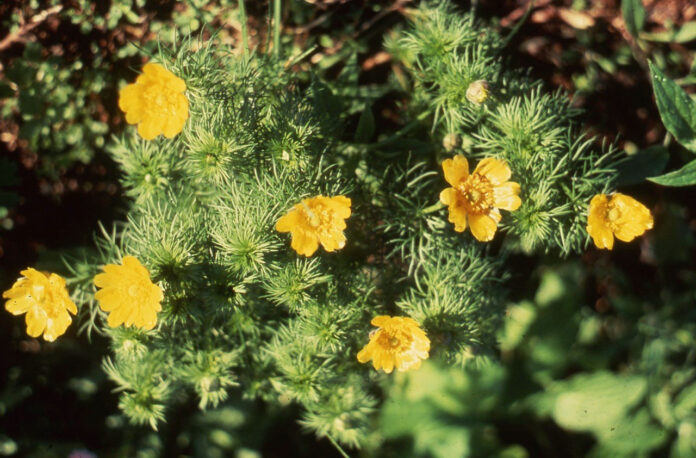by Sara Williams and Jackie Bantle
Last week we discussed several early blooming spring perennials that are completely hardy but under-utilized in the Prairie garden. This week we continue with three more later spring blooming perennials that are dependable and noteworthy.
Spring adonis (Adonis vernalis)
One of the hardiest and most lovely and dependable perennials, spring Adonis is also one of the least seen. According to Greek mythology, it was named after Adonis the Greek god of plants. The word vernalis means spring, the time when it blooms.
It forms a mound about 50 cm high of light green, finely dissected, almost ferny foliage. The single flowers, on 30 cm stems, are waxy yellow and buttercup-like. They are about 6 cm in diameter with 10 to 20 petals that open flat in early spring.
Spring adonis does best in evenly moist, well-drained soil well amended with organic matter. Plant spring adonis in the front of a border, a shade garden or a rock garden as it flourishes in both full sun and full shade.
Propagation
Spring adonis seeds need at least six weeks of temperatures below 5°C to initiate germination: it is best to sow seed directly outdoors in fall or very early spring. Seeds are available from Plant World Seeds (www.plant-world-seeds.com). Wrightman Alpine Nursery in New Brunswick sells plants. (www.wrightmanalpines.com)
Fernleaf clematis (Clematis hirsutissima)
Most prairie gardeners are familiar with clematis as a vine, but the herbaceous, non-climbing clematis are less well known. Hairy or fern-leafed clematis (C. hirsutissima) is native to the Great Plains states and was first collected by John Scott in 1872 in Colorado. The species name means hairy and describes the long silky hairs on its foliage which is much divided and almost fern-like. The blue flowers appear in spring on 60 cm (2 ft) stems and are followed by feathery seed heads. It’s a truly hardy, lovely and rare plant.
Grow plants in full sun or light shade in soil with average moisture that has been well amended with organic matter. Plants are well suited to the front or mid-range of a perennial border. Fernleaf clematis tolerates rabbits, deer and drought.
Propagation
They may be increased from seed or early spring division or propagated by cuttings in late spring before flowering. Plants are difficult to source but check with Honeywood Nursery in Parkside, Saskatchewan or Skinner’s Nursery in Roblin, Manitoba as possible suppliers.
Shield-leaf, astilboides (Astilboides tabularis)
If you have visited English gardens and marveled at (and had your photo taken with) Gunnera, here is a slightly smaller but much hardier version. Although unrelated, astilboides is the perfect antidote for “Gunnera withdrawal” when prairie garden travelers return home. The species name tabularis means table, a reference to the leaves. One of the common names, shield-leaf, describes the shield-like appearance of the foliage. Native to northern China, Manchuria and North Korea, where it grows in moist woodlands and near lakes and streams, Astilboides tabularis it is much hardier than its classification in many publications suggests. It has been grown for over a decade in a rural Saskatchewan garden (formerly zone 2, now designated as zone 3).
A bold plant of great architectural value, it is nevertheless well behaved, forming a slowly enlarging clump. Its large circular leaves are 30 to 45 cm (12-18 in.) in diameter and about 1 m (3 ft) in height. The leaf stalks are in the center of the leaf blade, giving them an umbrella-like appearance. As the genus name, astilboides, suggests, the creamy white flowers, formed on 120 cm (4 ft) stalks in early summer, resemble those of astilbe.
Plant astilboides in full or partial shade in humus rich but well drained soil. It demands even moisture but should not be water-logged. Mulching is beneficial. This is an excellent perennial for a shaded border or a woodland garden alongside ferns and hostas.
Propagation
If you have a friend with this remarkable plant, it is easily propagated by divisions in early spring. Seeds, available from Plant World Seeds, germinate easily under moist, room temperature conditions. Plants are available from Gardenworks in Burnaby, BC and Fraser Thimble Farms located on Salt Spring Island.
Tune in next week for our final part 3 in this series studying Underutilized Perennials.
This column is provided courtesy of the Saskatchewan Perennial Society (SPS; saskperennial@hotmail.com ). Check our website saskperennial.ca) or Facebook page (facebook.com/saskperennial). All Saskatchewan Perennial Society events are on hold until further notice.


